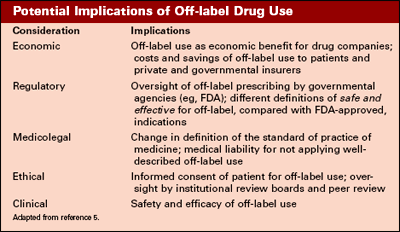Publication
Article
Pharmacy Times
Off-label Uses for Treating Pain
Author(s):
Safe, effective off-label prescribing begins with an understanding of clinical and legal implications of such actions.
Dr. Throm is an assistant professor ofpharmacy practice at MidwesternUniversity College of Pharmacy-Glendale, Glendale, Arizona.
Amitriptyline for neuropathicpain in an adult diabeticpatient; ketorolac for painrelief during a pediatric sickle-cell crisis;fentanyl (Actiq) lollipops during pregnancyfor refractory migraines; fentanyl(Fentora) buccal tablets for headaches;propofol for itching related to epiduralmorphine—as the pharmacist, wouldyou dispense these medications?1-5

Each scenario is an example of offlabelprescribing—prescribing a productnot FDA approved for that particularindication (indication not included in thepackage insert).2,6-10 More than 150 millionmentions of off-label uses werereported in the 160 most commonlyprescribed medications; one quarterwere supported by scientific rigor.6Couple this with the estimated 50 millionindividuals affected by pain, and itbecomes likely that patients may beprescribed an off-label medication forpain.11
Recent articles in the Wall StreetJournal paint a jaded, biased picture ofthe off-label use of opioid analgesics fortreating pain.3,4,12 Because off-label prescribingis common and controversial,pharmacists and other health care professionalsshould be familiar with theclinical and legal implications of suchoff-label prescribing.
Why Off-label Use Continues
Off-label prescribing is common forconditions such as cancer, AIDS/HIV,headaches, pain, pediatrics, pregnancy,psychiatric disorders, and rare diseases.1,2,5-7,10,12,13 Aggressive treatment,narrow labeling in the FDA-approvedpackage inserts, and lack of clinical trialsin select populations contribute tothis off-label use.2,13,14 It has been proposedthat off-label use stems from clinicaltrials in similar diseases or from"learning by doing."5,7
Off-label Uses for Pain
Nonsteroidal anti-inflammatory drugs(NSAIDs), acetaminophen, and opioidanalgesics are commonly used inpatients with acute and chronic pain;select patients may benefit from tricyclicantidepressants (TCAs) or epilepticsfor supplemental pain relief.11 Whenused at appropriate doses with carefulmonitoring, these agents are safe andeffective.
TCAs and Anticonvulsants
Neuropathic pain may be classifiedas 3 main types: postherpetic neuralgia(PHN), diabetic peripheral neuropathy(DPN), and trigeminal neuralgia (TN).1Antidepressants (amitriptyline), anticonvulsants(gabapentin), opioids (tramadol),and topical treatments (5%lidocaine patch) are commonly usedfor treating neuropathic pain.1 The onlyFDA-approved treatments, however,include the 5% lidocaine patch,gabapentin and pregabalin for PHN,pregabalin and duloxetine for DPN, andcarbamazepine for TN.1
Unlike the TCAs, which commonlycause anticholinergic effects, sedation,orthostatic hypotension/syncope, cardiacarrhythmias, and weight gain,duloxetine (serotonin-norepinephrinereuptake inhibitor) has a more favorableside-effect profile and FDA backing.1 Amitriptyline, the first-line agentfor neuropathic pain, is backed by clinicalevidence rather than FDA approvaland is considered off label.
Ketorolac
Ketorolac is commonly used foracute, short-term pain relief in adults.Ketorolac may be administered intravenouslyor orally, but its use is limitedto no more than 5 days due to adverseeffects (eg, bleeding, renal dysfunction).15 Although ketorolac is not FDAapproved for patients younger than 16years, it is commonly used in childrenwho have pain secondary to sickle-cellcrises.2
Opioid Analgesics
Triptans, select NSAIDs, and selectopioid analgesics are FDA-approvedagents commonly used for headaches.A study conducted in a specialtyheadache clinic, however, discoveredthat, of the 379 prescriptions written in1 month, approximately half met criteriafor off-label use.10 The 4 most commonoff-label drugs that accounted for morethan half of the off-label prescriptionsincluded antiepileptics (topiramate andlamotrigine), antidepressants (venlafaxine),and botulinum toxin type A.10
The use of opioid analgesics (Actiqand Fentora) for headache pain hasbeen a hot topic as evidenced by recentarticles in the Wall Street Journal.3,4 The information presented to thepublic may have been biased and mayhave instilled fear in the public aboutpain and addiction, promoting concernthat curbing the availability of opioidanalgesics may negatively impact thepatients who truly require opioids (eg,the nonaddicted pain patients withcancer or other chronic pain conditions).12
With the proper assessment andmanagement of both pain and addictionrisk by a trained professional,treatment strategies may be tailored tomeet individual needs.12 Although bothActiq and Fentora are FDA approvedfor cancer patients only, trainedproviders continue to prescribe theseagents off label for pain of noncancerorigin.12,16,17
Propofol
Common adverse drug events foropioid analgesics include constipation,respiratory depression, altered mentalstatus, and itching due to histaminerelease.11 Typical treatment for itchingmay include switching to a differentopioid, changing administration route,or administering cost-effective antihistamines(eg, diphenhydramine).11 Oneclinical study found that subhypnoticdoses of propofol relieved itching in apatient receiving epidural and intrathecalmorphine, however.18 The use ofpropofol for this indication is consideredoff label.
Resources for Off-label Use
Besides completing an evidencebasedliterature search, commonresources on off-label or unapproveduses of medications can be used:(1) American Hospital Formulary Servicerun by the American Society ofHealth-System Pharmacists (www.ashp.org/ahfs); (2) United States PharmacopoeiaDrug Information; and (3) Drugdexand Drug Evaluations, both maintainedby Micromedex (www.micromedex.com).5,7-9,19,20 In addition, Facts andComparisons' Off-Label Drug Factsassists health care professionals inidentifying published literature regardinga specific drug use that is not currentlyFDA approved.5
Many reimbursement claims may bedenied by private payers, Medicare, orMedicaid if prescribed off label, unlessthe medication is cited in these references(excluding Facts and Comparisons'Off-Label Drug Facts).7-9,13,20Published scientific evidence for druguse also can be used as part of theappeals and exceptions process.9 ThePhysicians' Desk Reference does notcontain information on off-label indications.8,10
Legal Implications of Off-label Use
Although it is legal for physicians toprescribe a medication for an off-labelindication, marketing and promotion ofoff-label indications by drug companiesis illegal.7,8,20 Numerous lawsuits havealleged off-label marketing by drugcompanies.20,21 Manufacturers are permittedto disseminate peer-reviewedpublished studies on the safety andeffectiveness of off-label uses thathave been or will be studied and submittedfor FDA approval.7,8,20 To makean educated evaluation of an off-labelindication, therapeutic letters or academicdetailing can help.21
There may be health-policy, regulatory,ethical, medicolegal, and economicimplications associated with off-labelprescribing (Table)5; therefore, variousfactors must be weighed when decidingwhen to prescribe an off-label drug(eg, clinical data, promotions, reimbursementhurdles).7
The following are suggestions tolimit malpractice claims due to off-labelprescribing: (1) discuss with thepatient that the prescribed drug is offlabel; (2) prescribe with the best intentionsto diagnose, treat, and directlybenefit the patient; and (3) base therecommendation on expert medicalopinion and sound, reputable peerreviewedscientific literature.22
The pharmacist is the final safetycheck before a patient uses an off-labelindication; it is important to be familiarwith off-label prescribing of pain medicationsto promote patient safety,which includes proper monitoring andindividual assessment.

References
- Jackson KC 2nd. Pharmacotherapy for neuropathic pain. Pain Pract. 2006;6:27-33.
- Eiland LS, Knight P. Evaluating the off-label use of medications in children. Am J Health Syst Pharm. 2006;63:1062-1065.
- Carreyrou J. Narcotic ?lollipop' is big seller despite FDA curbs. The Wall Street Journal. November 3, 2006.
- Carreyrou J, Goldstein J. Cephalon drug is tied to several deaths. Off-label marketing of cancer painkiller is focus of three probes. The Wall Street Journal. September 14, 2007.
- Demonaco HJ, Ali A, Hippel E. The major role of clinicians in the discovery of off-label drug therapies. Pharmacotherapy. 2006;26:323-332.
- Radley DC, Finkelstein SN, Stafford RS. Off-label prescribing among office-based physicians. Arch Intern Med. 2006;166:1021-1026.
- Hampton T. Experts weigh in on promotion, prescription of off-label drugs. JAMA. 2007;297:683-684.
- Blum RS. Legal considerations in off-label medication prescribing. Arch Intern Med. 2002;162:1777-1779.
- Medicare Rights Center. Off-base: the exclusion of off-label prescriptions from Medicare Part D coverage. August 2007. www.medicarerights.org. Accessed November 2, 2007.
- Loder EW, Biondi DM. Off-label prescribing of drugs in specialty headache practice. Headache. 2004;44:636-641.
- American Pain Society. Principles of Analgesic Use in the Treatment of Acute Pain and Cancer Pain. 5th ed. Glenview, IL: American Pain Society; 2003.
- Passik SD, Kirsh KL. Weighing in on the off-label use of Actiq for noncancer-related pain: a recipe for success or a recipe for disaster? Pain Med. 2007;8:130-133.
- Eastman P. Reimbursement policies discourage off-label drug use. Oncology Times. 2005;27:8,10.
- Benjamin DK Jr, Smith PB, Murphy MD, et al. Peer-reviewed publication of clinical trials completed for pediatric exclusivity. JAMA. 2006;296:1266-1273.
- Toradol package insert. Roche Pharmaceuticals. Nutley, NJ:2002.
- Actiq package insert. Cephalon Inc. Salt Lake City, UT:2007.
- Fentora package insert. Cephalon Inc. Salt Lake City, UT:2007.
- Borgeat A, Wilder-Smith OH, Saiah M, Rifat K. Subhypnotic doses of propofol relieve pruritus induced by epidural and intrathecal morphine. Anesthesiology. 1992;76:510-512.
- Watson J. Off-label drug use in cancer care. Hematology and Oncology News and Issues. March 2007;18-20. www.HONIonline.com. Accessed November 2, 2007.
- Watson J. Off-label drug use in cancer care-Part II. Hematology and Oncology News and Issues. April 2007;24-31. www.HONIonline.com. Accessed November 2, 2007.
- Kondro W. "This is the kind of information we need." CMAJ. 2007;176:430.
- Riley JB, Basilius PA. Physicians' liability for off-label prescriptions. Hematology and Oncology News and Issues. May/June 2007;24-27,37. www.HONIonline.com. Accessed November 2, 2007.







